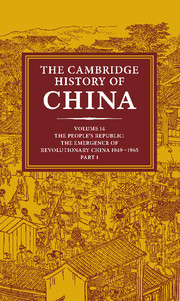Crossref Citations
This Book has been
cited by the following publications. This list is generated based on data provided by Crossref.
BORNSTEIN, GEORGE
1995.
CONSTRUCTING LITERATURE. Empiricism, Romanticism, and Textual Theory.
Annals of the New York Academy of Sciences,
Vol. 775,
Issue. 1,
p.
459.
Subritzky, John
2000.
Confronting Sukarno.
p.
1.
Lu, Qing
2008.
Government Control, Transaction Costs and Commitment Between the Hong Kong and Shanghai Banking Corporation (HSBC) and the Chinese Government.
Enterprise & Society,
Vol. 9,
Issue. 1,
p.
44.
Lu, Qing
2008.
Government Control, Transaction Costs and Commitment Between the Hong Kong and Shanghai Banking Corporation (HSBC) and the Chinese Government.
Enterprise and Society,
Vol. 9,
Issue. 1,
p.
44.
Rousset, Pierre
2009.
The International Encyclopedia of Revolution and Protest.
p.
1.
Bernardi, Andrea
and
Miani, Mattia
2014.
The long march of Chinese co-operatives: towards market economy, participation and sustainable development.
Asia Pacific Business Review,
Vol. 20,
Issue. 3,
p.
330.
Changfu, Xu
2015.
Why do we need practical wisdom? A Chinese lesson in the process of globalisation.
Global Discourse,
Vol. 5,
Issue. 4,
p.
519.
Liu, Xin
2018.
Reversing the view of ‘political pilgrims’: re-examining Italian travelogues about China in the 1950s.
Journal of Modern Italian Studies,
Vol. 23,
Issue. 3,
p.
256.
Khatoon, Aasia
Rahim, Nazim
and
Ali, Barkat
2018.
A Historical Perspective of China’s Peaceful Policies and its Rise as World Economic Power.
Liberal Arts and Social Sciences International Journal (LASSIJ),
Vol. 2,
Issue. 1,
p.
65.
Zhou, Qiren
2020.
Property Rights and Changes in China.
p.
25.
Xu, Jin
Gorsky, Martin
and
Mills, Anne
2020.
A path dependence analysis of hospital dominance in China (1949–2018): lessons for primary care strengthening.
Health Policy and Planning,
Vol. 35,
Issue. 2,
p.
167.
Zhang, Tony Huiquan
Hu, Jing
and
Zhang, Xichao
2020.
Disparities in Subjective Wellbeing: Political Status, Urban-Rural Divide, and Cohort Dynamics in China.
Chinese Sociological Review,
Vol. 52,
Issue. 1,
p.
56.
Wang, Greg G.
Doty, D. Harold
and
Yang, Shengbin
2022.
Re-examining the History of Human Resource Development Policy in China: From Local Indigenous Phenomena to Global Human Resource Development Knowledge.
Advances in Developing Human Resources,
Vol. 24,
Issue. 1,
p.
26.
Sui, Qing-yuan
2022.
Money and Government.
p.
29.
Salonia, Matteo
and
Mueller, Christian
2022.
Travel Writings on Asia.
p.
261.
Samarani, Guido
2023.
East and West Entangled (17th-21st Centuries).
Vol. 2,
Issue. ,
p.
181.
Cai, Xiang
2024.
Lucky Beneficiaries or Collateral Damage? The Irregular Timing and Arrangement of Chinese Watchdog Agencies.
Journal of Asian and African Studies,
Vol. 59,
Issue. 4,
p.
1193.
Qian, Xuechao
2024.
Revolutionized life: long-term effects of childhood exposure to persecution on human capital and marital sorting.
Journal of Population Economics,
Vol. 37,
Issue. 1,





